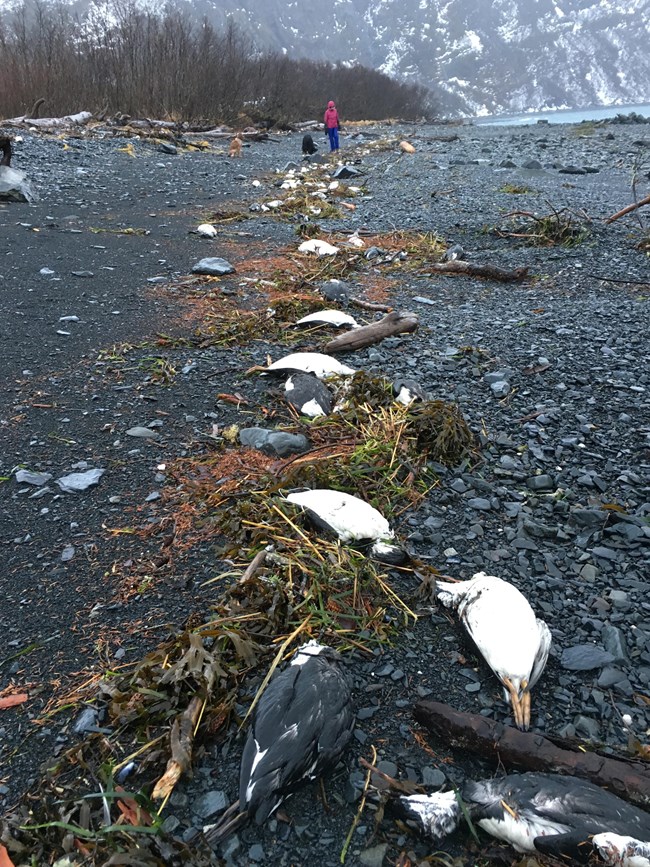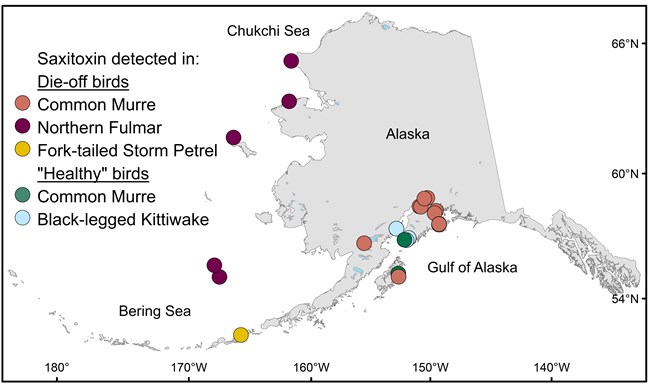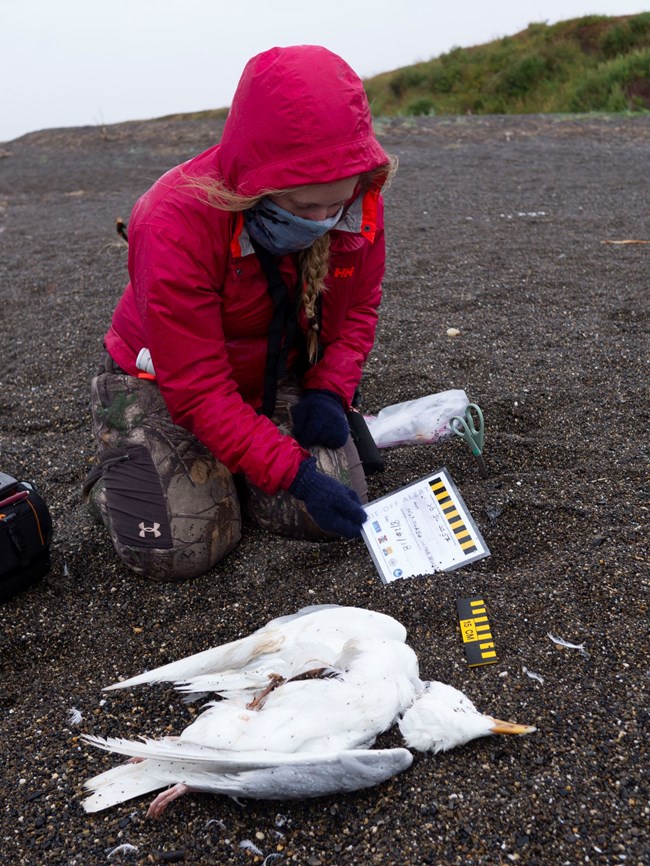Last updated: March 31, 2025
Article
Harmful Algal Toxins in Alaska's Seabirds and Marine Mammals

What's Happening to Alaska's Marine Life?
Ocean temperatures around Alaska are warming. As a result, Alaska’s seabirds and marine mammals are being exposed to increasing levels of toxins. Warmer waters result in rapid buildups of harmful algae populations. These harmful algal blooms (HABs) harbor phytoplankton known to produce neurotoxins. Marine birds and mammals, then, ingest the algal toxins by consuming prey that feeds on the contaminated phytoplankton. Maternal adult mammals also pass the toxins to their offspring via amniotic fluid and milk.
Warming waters also contribute to more rapid melting of sea ice, allowing industrial ships access to previously closed areas. These vessels may discharge additional toxic phytoplankton into the ocean through ballast water.
Saxitoxin (STX) and domoic acid (DA) are the most common of these neurotoxins in Alaska. Both affect the central nervous system of vertebrates. Saxitoxin causes paralytic shellfish poisoning and can lead to respiratory failure and death. Domoic acid, the toxin responsible for amnesic shellfish poisoning, causes overstimulation of the central nervous system. High levels of DA can result in seizures, coma and even death in marine birds and mammals. DA intoxication is also believed to be a factor in animal strandings and ship collisions. During the last 20 years more than 40% of unusual marine mammal deaths in the lower United States have been attributed to algal toxin exposure.
How Are We Tracking HABs in Alaska?
Recent studies have helped shed light on the prevalence of algal toxins in Alaska’s coastal waters. Their results will be helpful in directing future studies and will advance our understanding of the impacts of HABs in the Arctic and subarctic ecosystem.
The study Prevalence of algal toxins in Alaskan marine mammals foraging in a changing arctic and subarctic environment examines over 900 marine mammals to document the presence and extent of algal toxins in Alaskan waters. The area of study extended along the entire Alaskan coast, from the Beaufort Sea to the Gulf of Alaska. Thirteen different mammal species were examined, including three whale species, multiple seal species, harbor porpoises, Steller sea lions, Pacific walruses, and northern sea otters. Samples collected from the test subjects consisted of, among others, feces, urine, and stomach and intestinal contents. Both the prevalence and concentrations of the algal toxins were evaluated.
At least one of the two algal toxins was found in one or more subjects from all 13 species sampled, and 46 individuals contained concentrations of both. Sixty-eight percent of the bowhead whales sampled tested positive for DA, followed closely by harbor seals at 67%. Domoic acid was also found in one fetus each of a beluga whale, harbor porpoise and a Steller sea lion. Equally notable, these toxins were found in mammals taken from throughout the study area.
While saxitoxin was present in fewer test subjects, 50% of the humpback whales tested positive for the toxin. Bowhead whales had the next highest prevalence at 32%, followed closely by walruses at 28%. All adult mammals in the study had ingested the toxins through prey. The fetuses and suckling young were also exposed through amniotic fluid and milk.
Pacific walruses measured the highest concentrations of both DA and STX. In fact, DA concentration levels were similar to those of California sea lions suffering from DA toxicosis. This was a surprising discovery, as the subjects sampled came from waters generally not considered favorable to the occurrence of harmful algal blooms.

Lefebvre, K.A., et al. 2016. Prevalence of algal toxins in Alaskan marine mammals in a changing arctic & subarctic environment. Harmful Algae 55:13-24.
e

Algal Toxins and Alaska's Seabirds
Alaska has experienced unusually large and consistent seabird die-offs beginning in 2015. In 2015 and 2016 common murres were particularly hard hit, with over 45,000 washing up dead in the Gulf of Alaska, alone. In response, the USGS Alaska Science Center, in collaboration with NOAA and other partners, tested multiple seabirds, including common murres, black-legged kittiwakes and northern fulmars, for algal toxins. A summary of the research reveals that STX was common in 45% of seabirds collected during recent die-offs, and in 35% of healthy birds. Trace levels of domoic acid were found in only 1% of the seabirds tested.
Levels of saxitoxin varied by species. For example, detectable levels of the neurotoxin were found in about one-third of both healthy and die-off murres and kittiwakes. In contrast, 90% of northern fulmars showed detectable levels of saxitoxin.
The Alaska Science Center also investigated fish and invertebrates typically preyed on by seabirds. Among the subjects tested, 31% contained detectable levels of saxitoxin, and 12% showed detectable levels of domoic acid.
Thus far is it unclear what, if any, role these algal toxins played in the deaths of the birds tested. As yet, lethal doses of many algal toxins in wildlife species has not been determined. To better understand their effects on seabirds, the USGS National Wildlife Health Center is currently conducting laboratory tests to establish lethal levels, and to examine the effects of repeated exposure of lower doses of STX and DA. They are also studying how HAB toxins move through the marine ecosystem.
Read a more detailed study on algal toxins in Alaska seabirds at: https://www.sciencedirect.com/science/article/pii/S1568988319302033?via%3Dihub
Seabird graphic details: https://www.usgs.gov/media/images/map-sampled-seabirds-detectable-levels-saxitoxin-alaska
In Conclusion
These studies suggest that many of Alaska’s marine wildlife species already carry detectable levels of algal toxins in their system. Data from studies of California sea lions indicate that Alaskan marine mammals may already be near toxic exposures. It also demonstrates that HABs are well established, from the southeastern part of the state to the Arctic Ocean, and now occur in areas previously considered too cold to support them.While HABs are not new to Artic and subarctic waters, current climate trends seem likely to increase their distribution and duration. These developments could have wide-ranging negative effects on Alaska’s foraging seabirds and marine mammals, and the coastal communities that depend on them. Though generally not the cause of mortality in Alaska’s marine species, harmful algal blooms may compound the impacts of existing stressors, such as ship strikes and reduced prey availability, related to a rapidly changing environment.
To learn more about National Park Service efforts to study seabird die-offs in Alaska visit: Seabird Die-Offs - Alaska Nature and Science (U.S. National Park Service)

Tags
- bering land bridge national preserve
- cape krusenstern national monument
- glacier bay national park & preserve
- katmai national park & preserve
- kenai fjords national park
- lake clark national park & preserve
- wrangell - st elias national park & preserve
- alaska
- alaska climate change
- marine
- marine algae
- marine animals and birds
- climate change
- climate change effects
- oceans
- algae
